Analyzing Whistleblowing Impact on Organizational Learning
VerifiedAdded on 2023/06/11
|14
|4012
|453
Literature Review
AI Summary
This literature review explores the impact of whistleblowing on organizational learning, particularly within the NHS context. It examines the Public Interest Disclosure Act 1998 and its effects on protecting whistleblowers, while also investigating how organizations respond to whistleblowing and what they learn from such cases. The review delves into the rights of whistleblowers, employer responsibilities, and the potential risks involved. It identifies a gap in the existing literature, noting a need for more in-depth studies on the impact of whistleblowing in UK organizations. The research methodology includes a qualitative approach, employing ethnographic and case study strategies to provide rich and detailed insights. The review concludes by emphasizing the importance of accountability and appropriate legal measures to protect whistleblowers and ensure their safety, highlighting the cost to external whistleblowing as it puts the reputation of the organization at stake and embroils the organization in a long-drawn legal battle. Desklib provides access to similar solved assignments and resources for students.
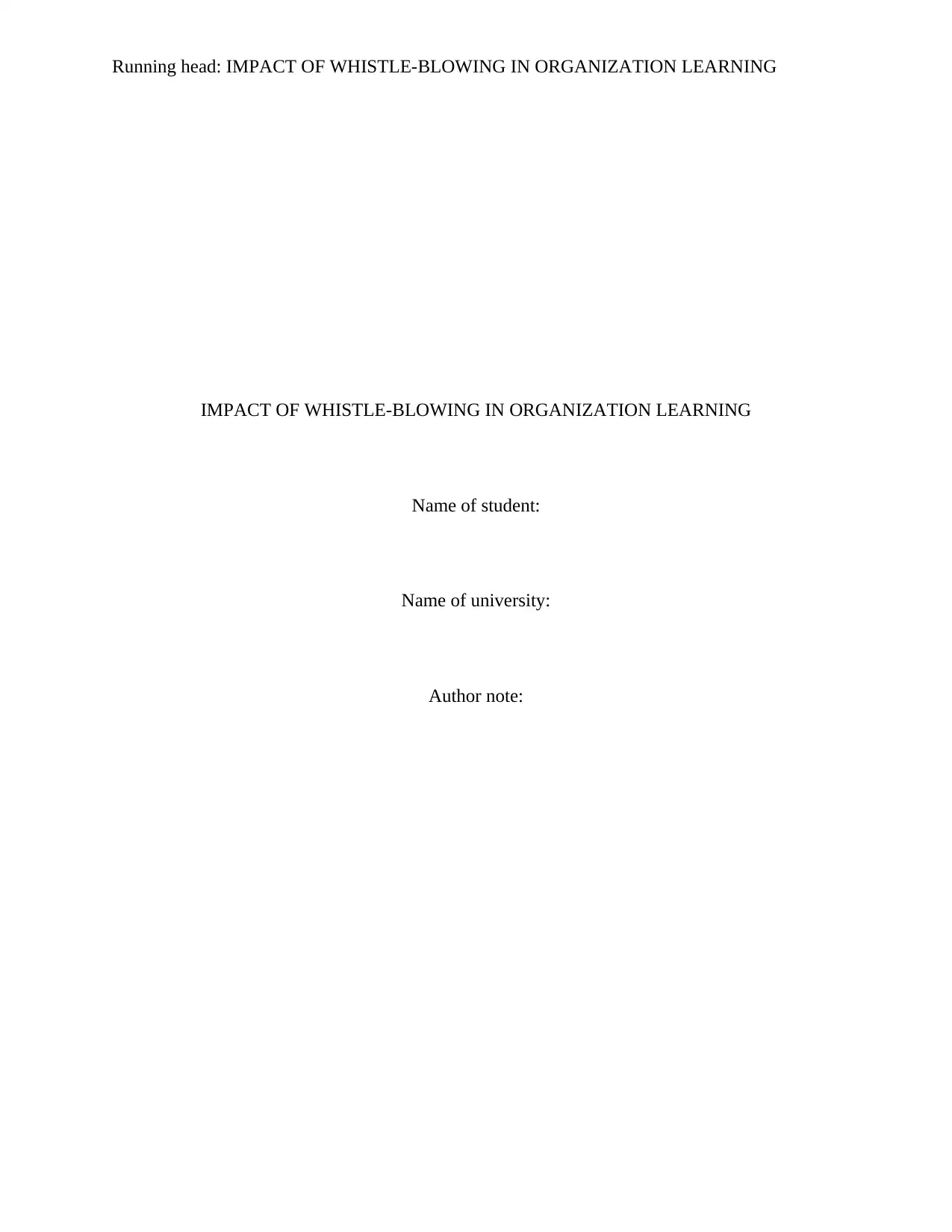
Running head: IMPACT OF WHISTLE-BLOWING IN ORGANIZATION LEARNING
IMPACT OF WHISTLE-BLOWING IN ORGANIZATION LEARNING
Name of student:
Name of university:
Author note:
IMPACT OF WHISTLE-BLOWING IN ORGANIZATION LEARNING
Name of student:
Name of university:
Author note:
Paraphrase This Document
Need a fresh take? Get an instant paraphrase of this document with our AI Paraphraser
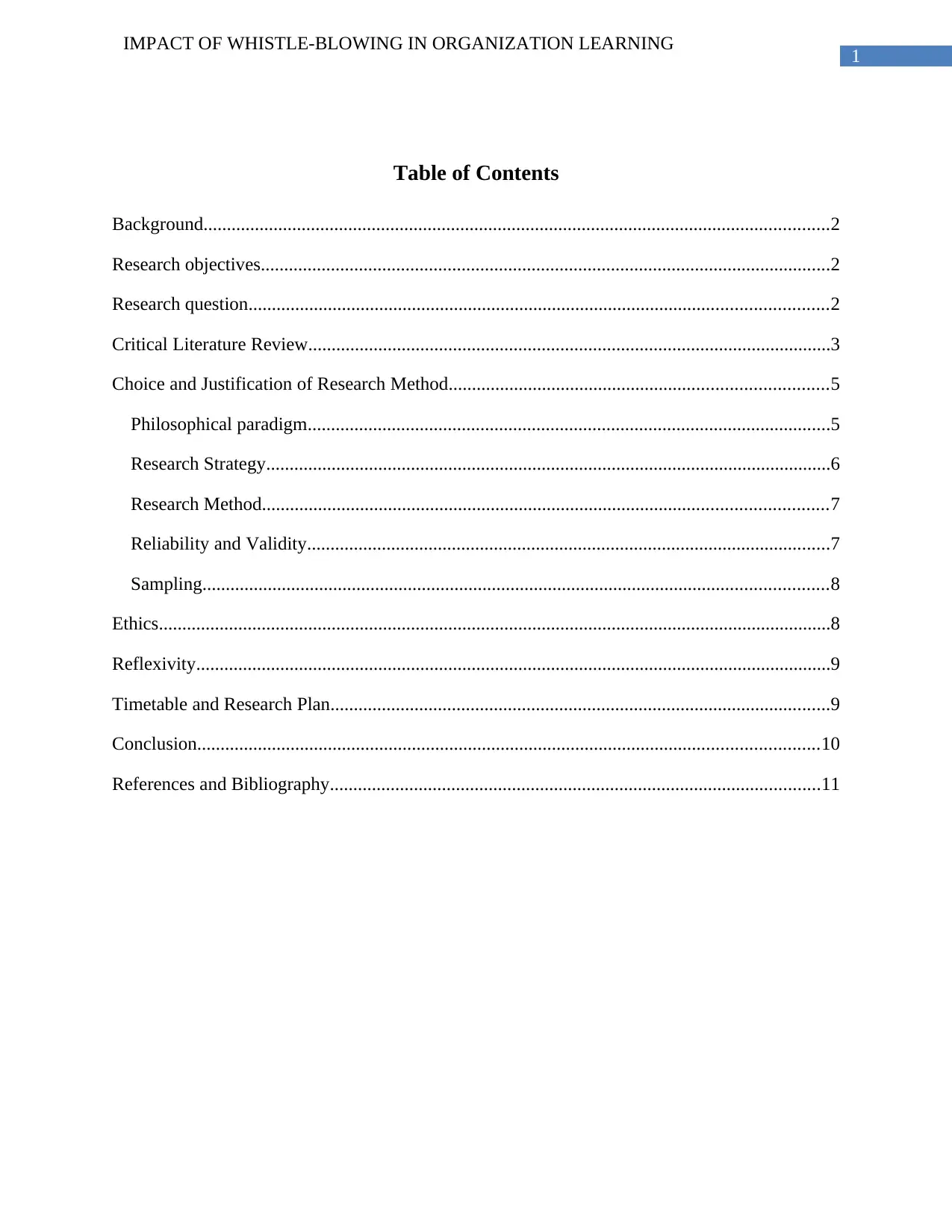
1
IMPACT OF WHISTLE-BLOWING IN ORGANIZATION LEARNING
Table of Contents
Background......................................................................................................................................2
Research objectives..........................................................................................................................2
Research question............................................................................................................................2
Critical Literature Review................................................................................................................3
Choice and Justification of Research Method.................................................................................5
Philosophical paradigm................................................................................................................5
Research Strategy.........................................................................................................................6
Research Method.........................................................................................................................7
Reliability and Validity................................................................................................................7
Sampling......................................................................................................................................8
Ethics................................................................................................................................................8
Reflexivity........................................................................................................................................9
Timetable and Research Plan...........................................................................................................9
Conclusion.....................................................................................................................................10
References and Bibliography.........................................................................................................11
IMPACT OF WHISTLE-BLOWING IN ORGANIZATION LEARNING
Table of Contents
Background......................................................................................................................................2
Research objectives..........................................................................................................................2
Research question............................................................................................................................2
Critical Literature Review................................................................................................................3
Choice and Justification of Research Method.................................................................................5
Philosophical paradigm................................................................................................................5
Research Strategy.........................................................................................................................6
Research Method.........................................................................................................................7
Reliability and Validity................................................................................................................7
Sampling......................................................................................................................................8
Ethics................................................................................................................................................8
Reflexivity........................................................................................................................................9
Timetable and Research Plan...........................................................................................................9
Conclusion.....................................................................................................................................10
References and Bibliography.........................................................................................................11
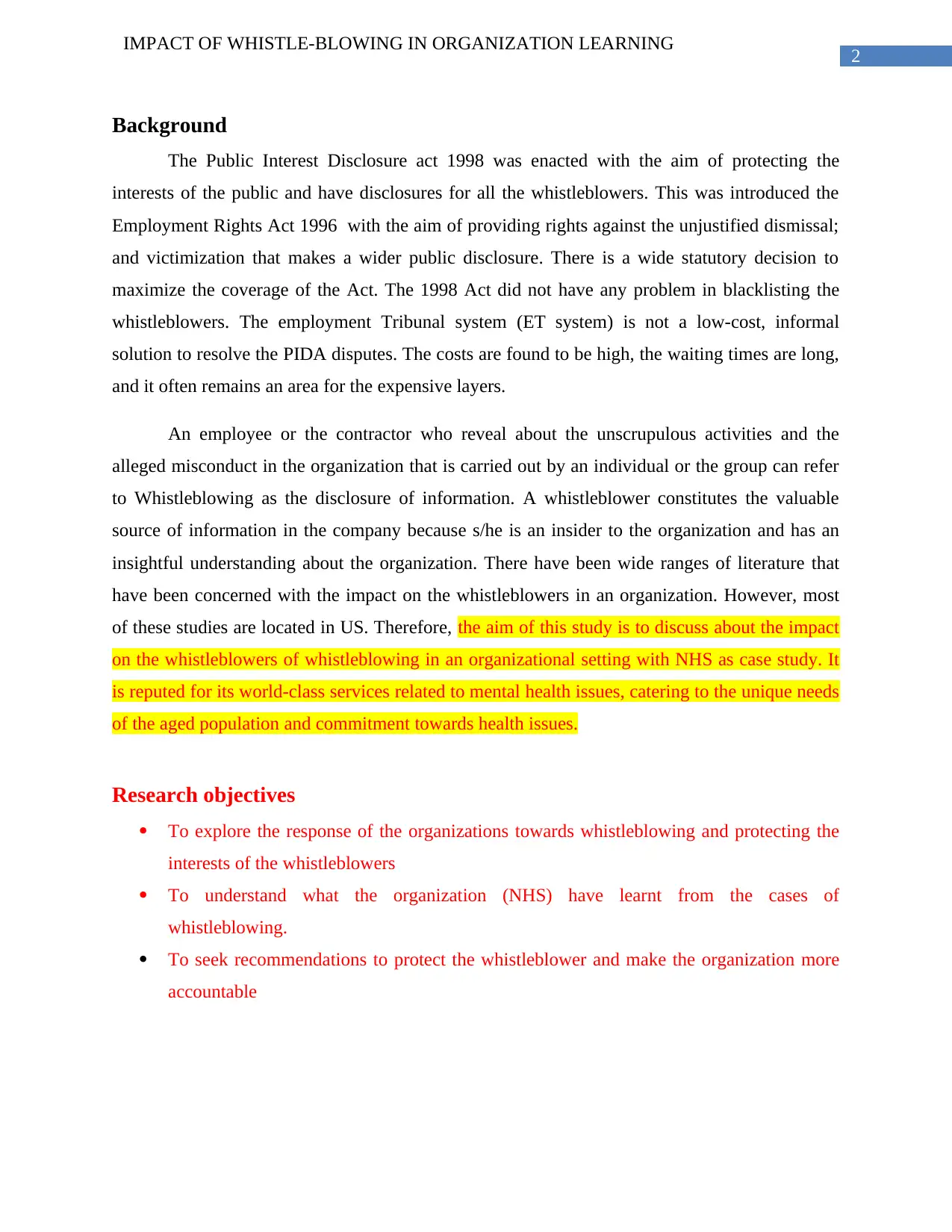
2
IMPACT OF WHISTLE-BLOWING IN ORGANIZATION LEARNING
Background
The Public Interest Disclosure act 1998 was enacted with the aim of protecting the
interests of the public and have disclosures for all the whistleblowers. This was introduced the
Employment Rights Act 1996 with the aim of providing rights against the unjustified dismissal;
and victimization that makes a wider public disclosure. There is a wide statutory decision to
maximize the coverage of the Act. The 1998 Act did not have any problem in blacklisting the
whistleblowers. The employment Tribunal system (ET system) is not a low-cost, informal
solution to resolve the PIDA disputes. The costs are found to be high, the waiting times are long,
and it often remains an area for the expensive layers.
An employee or the contractor who reveal about the unscrupulous activities and the
alleged misconduct in the organization that is carried out by an individual or the group can refer
to Whistleblowing as the disclosure of information. A whistleblower constitutes the valuable
source of information in the company because s/he is an insider to the organization and has an
insightful understanding about the organization. There have been wide ranges of literature that
have been concerned with the impact on the whistleblowers in an organization. However, most
of these studies are located in US. Therefore, the aim of this study is to discuss about the impact
on the whistleblowers of whistleblowing in an organizational setting with NHS as case study. It
is reputed for its world-class services related to mental health issues, catering to the unique needs
of the aged population and commitment towards health issues.
Research objectives
To explore the response of the organizations towards whistleblowing and protecting the
interests of the whistleblowers
To understand what the organization (NHS) have learnt from the cases of
whistleblowing.
To seek recommendations to protect the whistleblower and make the organization more
accountable
IMPACT OF WHISTLE-BLOWING IN ORGANIZATION LEARNING
Background
The Public Interest Disclosure act 1998 was enacted with the aim of protecting the
interests of the public and have disclosures for all the whistleblowers. This was introduced the
Employment Rights Act 1996 with the aim of providing rights against the unjustified dismissal;
and victimization that makes a wider public disclosure. There is a wide statutory decision to
maximize the coverage of the Act. The 1998 Act did not have any problem in blacklisting the
whistleblowers. The employment Tribunal system (ET system) is not a low-cost, informal
solution to resolve the PIDA disputes. The costs are found to be high, the waiting times are long,
and it often remains an area for the expensive layers.
An employee or the contractor who reveal about the unscrupulous activities and the
alleged misconduct in the organization that is carried out by an individual or the group can refer
to Whistleblowing as the disclosure of information. A whistleblower constitutes the valuable
source of information in the company because s/he is an insider to the organization and has an
insightful understanding about the organization. There have been wide ranges of literature that
have been concerned with the impact on the whistleblowers in an organization. However, most
of these studies are located in US. Therefore, the aim of this study is to discuss about the impact
on the whistleblowers of whistleblowing in an organizational setting with NHS as case study. It
is reputed for its world-class services related to mental health issues, catering to the unique needs
of the aged population and commitment towards health issues.
Research objectives
To explore the response of the organizations towards whistleblowing and protecting the
interests of the whistleblowers
To understand what the organization (NHS) have learnt from the cases of
whistleblowing.
To seek recommendations to protect the whistleblower and make the organization more
accountable
⊘ This is a preview!⊘
Do you want full access?
Subscribe today to unlock all pages.

Trusted by 1+ million students worldwide
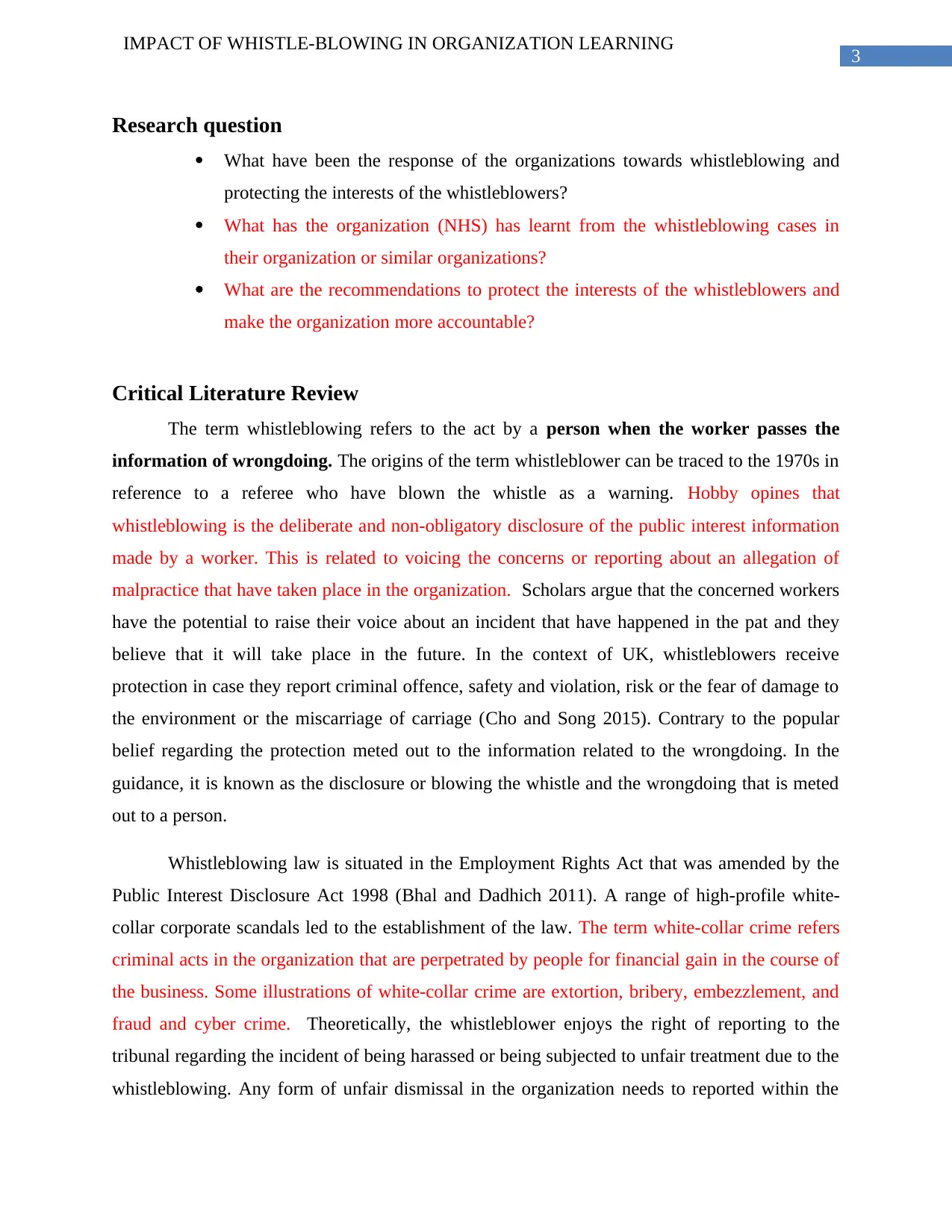
3
IMPACT OF WHISTLE-BLOWING IN ORGANIZATION LEARNING
Research question
What have been the response of the organizations towards whistleblowing and
protecting the interests of the whistleblowers?
What has the organization (NHS) has learnt from the whistleblowing cases in
their organization or similar organizations?
What are the recommendations to protect the interests of the whistleblowers and
make the organization more accountable?
Critical Literature Review
The term whistleblowing refers to the act by a person when the worker passes the
information of wrongdoing. The origins of the term whistleblower can be traced to the 1970s in
reference to a referee who have blown the whistle as a warning. Hobby opines that
whistleblowing is the deliberate and non-obligatory disclosure of the public interest information
made by a worker. This is related to voicing the concerns or reporting about an allegation of
malpractice that have taken place in the organization. Scholars argue that the concerned workers
have the potential to raise their voice about an incident that have happened in the pat and they
believe that it will take place in the future. In the context of UK, whistleblowers receive
protection in case they report criminal offence, safety and violation, risk or the fear of damage to
the environment or the miscarriage of carriage (Cho and Song 2015). Contrary to the popular
belief regarding the protection meted out to the information related to the wrongdoing. In the
guidance, it is known as the disclosure or blowing the whistle and the wrongdoing that is meted
out to a person.
Whistleblowing law is situated in the Employment Rights Act that was amended by the
Public Interest Disclosure Act 1998 (Bhal and Dadhich 2011). A range of high-profile white-
collar corporate scandals led to the establishment of the law. The term white-collar crime refers
criminal acts in the organization that are perpetrated by people for financial gain in the course of
the business. Some illustrations of white-collar crime are extortion, bribery, embezzlement, and
fraud and cyber crime. Theoretically, the whistleblower enjoys the right of reporting to the
tribunal regarding the incident of being harassed or being subjected to unfair treatment due to the
whistleblowing. Any form of unfair dismissal in the organization needs to reported within the
IMPACT OF WHISTLE-BLOWING IN ORGANIZATION LEARNING
Research question
What have been the response of the organizations towards whistleblowing and
protecting the interests of the whistleblowers?
What has the organization (NHS) has learnt from the whistleblowing cases in
their organization or similar organizations?
What are the recommendations to protect the interests of the whistleblowers and
make the organization more accountable?
Critical Literature Review
The term whistleblowing refers to the act by a person when the worker passes the
information of wrongdoing. The origins of the term whistleblower can be traced to the 1970s in
reference to a referee who have blown the whistle as a warning. Hobby opines that
whistleblowing is the deliberate and non-obligatory disclosure of the public interest information
made by a worker. This is related to voicing the concerns or reporting about an allegation of
malpractice that have taken place in the organization. Scholars argue that the concerned workers
have the potential to raise their voice about an incident that have happened in the pat and they
believe that it will take place in the future. In the context of UK, whistleblowers receive
protection in case they report criminal offence, safety and violation, risk or the fear of damage to
the environment or the miscarriage of carriage (Cho and Song 2015). Contrary to the popular
belief regarding the protection meted out to the information related to the wrongdoing. In the
guidance, it is known as the disclosure or blowing the whistle and the wrongdoing that is meted
out to a person.
Whistleblowing law is situated in the Employment Rights Act that was amended by the
Public Interest Disclosure Act 1998 (Bhal and Dadhich 2011). A range of high-profile white-
collar corporate scandals led to the establishment of the law. The term white-collar crime refers
criminal acts in the organization that are perpetrated by people for financial gain in the course of
the business. Some illustrations of white-collar crime are extortion, bribery, embezzlement, and
fraud and cyber crime. Theoretically, the whistleblower enjoys the right of reporting to the
tribunal regarding the incident of being harassed or being subjected to unfair treatment due to the
whistleblowing. Any form of unfair dismissal in the organization needs to reported within the
Paraphrase This Document
Need a fresh take? Get an instant paraphrase of this document with our AI Paraphraser
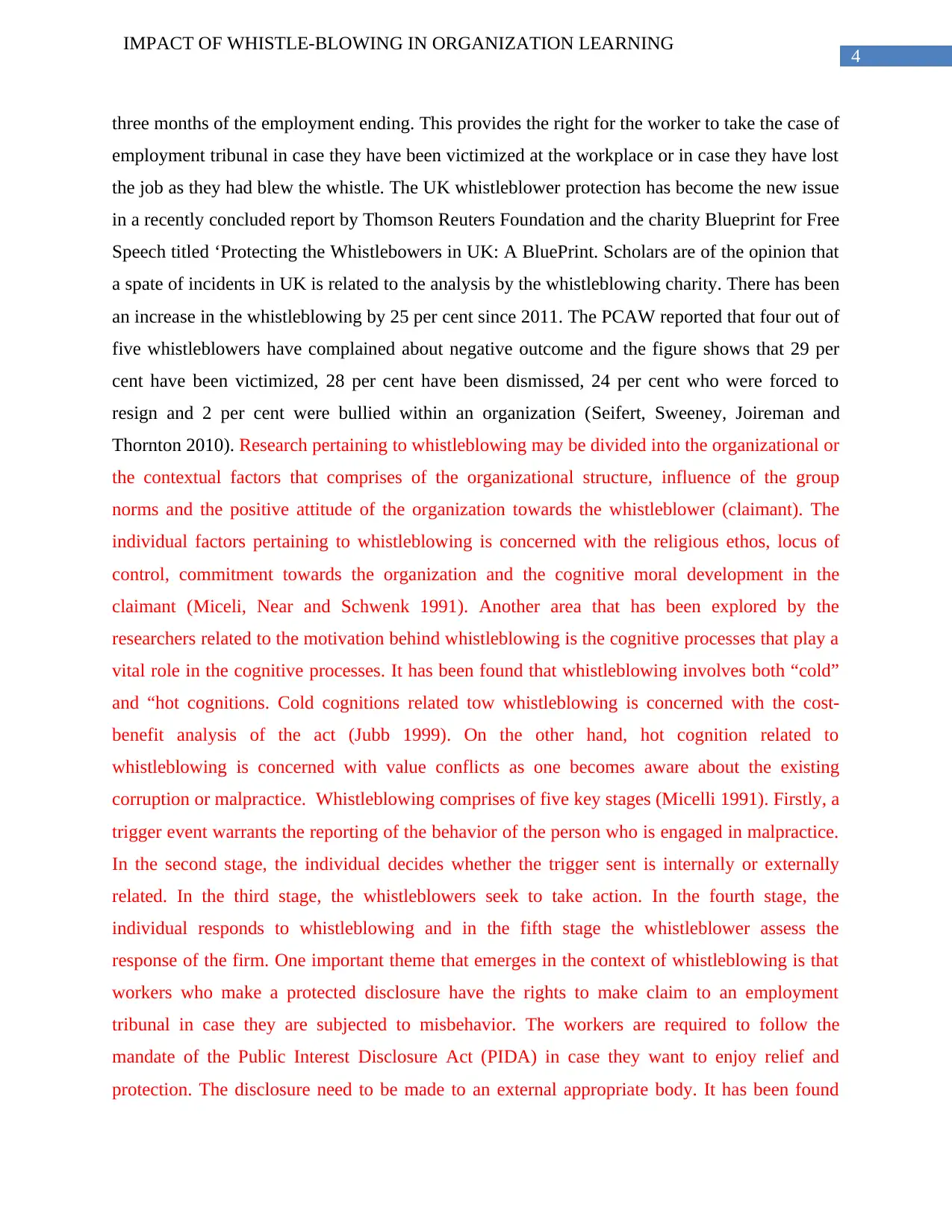
4
IMPACT OF WHISTLE-BLOWING IN ORGANIZATION LEARNING
three months of the employment ending. This provides the right for the worker to take the case of
employment tribunal in case they have been victimized at the workplace or in case they have lost
the job as they had blew the whistle. The UK whistleblower protection has become the new issue
in a recently concluded report by Thomson Reuters Foundation and the charity Blueprint for Free
Speech titled ‘Protecting the Whistlebowers in UK: A BluePrint. Scholars are of the opinion that
a spate of incidents in UK is related to the analysis by the whistleblowing charity. There has been
an increase in the whistleblowing by 25 per cent since 2011. The PCAW reported that four out of
five whistleblowers have complained about negative outcome and the figure shows that 29 per
cent have been victimized, 28 per cent have been dismissed, 24 per cent who were forced to
resign and 2 per cent were bullied within an organization (Seifert, Sweeney, Joireman and
Thornton 2010). Research pertaining to whistleblowing may be divided into the organizational or
the contextual factors that comprises of the organizational structure, influence of the group
norms and the positive attitude of the organization towards the whistleblower (claimant). The
individual factors pertaining to whistleblowing is concerned with the religious ethos, locus of
control, commitment towards the organization and the cognitive moral development in the
claimant (Miceli, Near and Schwenk 1991). Another area that has been explored by the
researchers related to the motivation behind whistleblowing is the cognitive processes that play a
vital role in the cognitive processes. It has been found that whistleblowing involves both “cold”
and “hot cognitions. Cold cognitions related tow whistleblowing is concerned with the cost-
benefit analysis of the act (Jubb 1999). On the other hand, hot cognition related to
whistleblowing is concerned with value conflicts as one becomes aware about the existing
corruption or malpractice. Whistleblowing comprises of five key stages (Micelli 1991). Firstly, a
trigger event warrants the reporting of the behavior of the person who is engaged in malpractice.
In the second stage, the individual decides whether the trigger sent is internally or externally
related. In the third stage, the whistleblowers seek to take action. In the fourth stage, the
individual responds to whistleblowing and in the fifth stage the whistleblower assess the
response of the firm. One important theme that emerges in the context of whistleblowing is that
workers who make a protected disclosure have the rights to make claim to an employment
tribunal in case they are subjected to misbehavior. The workers are required to follow the
mandate of the Public Interest Disclosure Act (PIDA) in case they want to enjoy relief and
protection. The disclosure need to be made to an external appropriate body. It has been found
IMPACT OF WHISTLE-BLOWING IN ORGANIZATION LEARNING
three months of the employment ending. This provides the right for the worker to take the case of
employment tribunal in case they have been victimized at the workplace or in case they have lost
the job as they had blew the whistle. The UK whistleblower protection has become the new issue
in a recently concluded report by Thomson Reuters Foundation and the charity Blueprint for Free
Speech titled ‘Protecting the Whistlebowers in UK: A BluePrint. Scholars are of the opinion that
a spate of incidents in UK is related to the analysis by the whistleblowing charity. There has been
an increase in the whistleblowing by 25 per cent since 2011. The PCAW reported that four out of
five whistleblowers have complained about negative outcome and the figure shows that 29 per
cent have been victimized, 28 per cent have been dismissed, 24 per cent who were forced to
resign and 2 per cent were bullied within an organization (Seifert, Sweeney, Joireman and
Thornton 2010). Research pertaining to whistleblowing may be divided into the organizational or
the contextual factors that comprises of the organizational structure, influence of the group
norms and the positive attitude of the organization towards the whistleblower (claimant). The
individual factors pertaining to whistleblowing is concerned with the religious ethos, locus of
control, commitment towards the organization and the cognitive moral development in the
claimant (Miceli, Near and Schwenk 1991). Another area that has been explored by the
researchers related to the motivation behind whistleblowing is the cognitive processes that play a
vital role in the cognitive processes. It has been found that whistleblowing involves both “cold”
and “hot cognitions. Cold cognitions related tow whistleblowing is concerned with the cost-
benefit analysis of the act (Jubb 1999). On the other hand, hot cognition related to
whistleblowing is concerned with value conflicts as one becomes aware about the existing
corruption or malpractice. Whistleblowing comprises of five key stages (Micelli 1991). Firstly, a
trigger event warrants the reporting of the behavior of the person who is engaged in malpractice.
In the second stage, the individual decides whether the trigger sent is internally or externally
related. In the third stage, the whistleblowers seek to take action. In the fourth stage, the
individual responds to whistleblowing and in the fifth stage the whistleblower assess the
response of the firm. One important theme that emerges in the context of whistleblowing is that
workers who make a protected disclosure have the rights to make claim to an employment
tribunal in case they are subjected to misbehavior. The workers are required to follow the
mandate of the Public Interest Disclosure Act (PIDA) in case they want to enjoy relief and
protection. The disclosure need to be made to an external appropriate body. It has been found
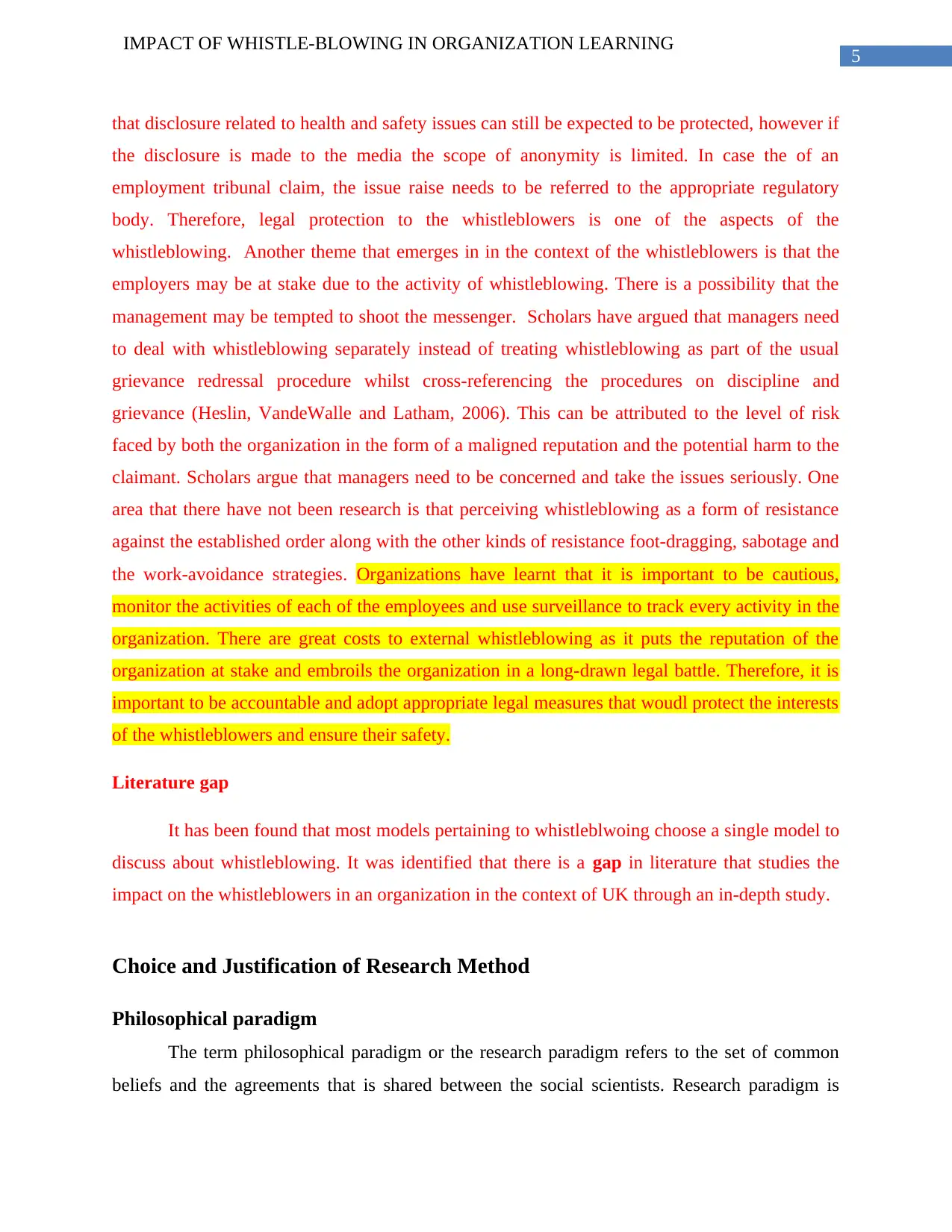
5
IMPACT OF WHISTLE-BLOWING IN ORGANIZATION LEARNING
that disclosure related to health and safety issues can still be expected to be protected, however if
the disclosure is made to the media the scope of anonymity is limited. In case the of an
employment tribunal claim, the issue raise needs to be referred to the appropriate regulatory
body. Therefore, legal protection to the whistleblowers is one of the aspects of the
whistleblowing. Another theme that emerges in in the context of the whistleblowers is that the
employers may be at stake due to the activity of whistleblowing. There is a possibility that the
management may be tempted to shoot the messenger. Scholars have argued that managers need
to deal with whistleblowing separately instead of treating whistleblowing as part of the usual
grievance redressal procedure whilst cross-referencing the procedures on discipline and
grievance (Heslin, VandeWalle and Latham, 2006). This can be attributed to the level of risk
faced by both the organization in the form of a maligned reputation and the potential harm to the
claimant. Scholars argue that managers need to be concerned and take the issues seriously. One
area that there have not been research is that perceiving whistleblowing as a form of resistance
against the established order along with the other kinds of resistance foot-dragging, sabotage and
the work-avoidance strategies. Organizations have learnt that it is important to be cautious,
monitor the activities of each of the employees and use surveillance to track every activity in the
organization. There are great costs to external whistleblowing as it puts the reputation of the
organization at stake and embroils the organization in a long-drawn legal battle. Therefore, it is
important to be accountable and adopt appropriate legal measures that woudl protect the interests
of the whistleblowers and ensure their safety.
Literature gap
It has been found that most models pertaining to whistleblwoing choose a single model to
discuss about whistleblowing. It was identified that there is a gap in literature that studies the
impact on the whistleblowers in an organization in the context of UK through an in-depth study.
Choice and Justification of Research Method
Philosophical paradigm
The term philosophical paradigm or the research paradigm refers to the set of common
beliefs and the agreements that is shared between the social scientists. Research paradigm is
IMPACT OF WHISTLE-BLOWING IN ORGANIZATION LEARNING
that disclosure related to health and safety issues can still be expected to be protected, however if
the disclosure is made to the media the scope of anonymity is limited. In case the of an
employment tribunal claim, the issue raise needs to be referred to the appropriate regulatory
body. Therefore, legal protection to the whistleblowers is one of the aspects of the
whistleblowing. Another theme that emerges in in the context of the whistleblowers is that the
employers may be at stake due to the activity of whistleblowing. There is a possibility that the
management may be tempted to shoot the messenger. Scholars have argued that managers need
to deal with whistleblowing separately instead of treating whistleblowing as part of the usual
grievance redressal procedure whilst cross-referencing the procedures on discipline and
grievance (Heslin, VandeWalle and Latham, 2006). This can be attributed to the level of risk
faced by both the organization in the form of a maligned reputation and the potential harm to the
claimant. Scholars argue that managers need to be concerned and take the issues seriously. One
area that there have not been research is that perceiving whistleblowing as a form of resistance
against the established order along with the other kinds of resistance foot-dragging, sabotage and
the work-avoidance strategies. Organizations have learnt that it is important to be cautious,
monitor the activities of each of the employees and use surveillance to track every activity in the
organization. There are great costs to external whistleblowing as it puts the reputation of the
organization at stake and embroils the organization in a long-drawn legal battle. Therefore, it is
important to be accountable and adopt appropriate legal measures that woudl protect the interests
of the whistleblowers and ensure their safety.
Literature gap
It has been found that most models pertaining to whistleblwoing choose a single model to
discuss about whistleblowing. It was identified that there is a gap in literature that studies the
impact on the whistleblowers in an organization in the context of UK through an in-depth study.
Choice and Justification of Research Method
Philosophical paradigm
The term philosophical paradigm or the research paradigm refers to the set of common
beliefs and the agreements that is shared between the social scientists. Research paradigm is
⊘ This is a preview!⊘
Do you want full access?
Subscribe today to unlock all pages.

Trusted by 1+ million students worldwide
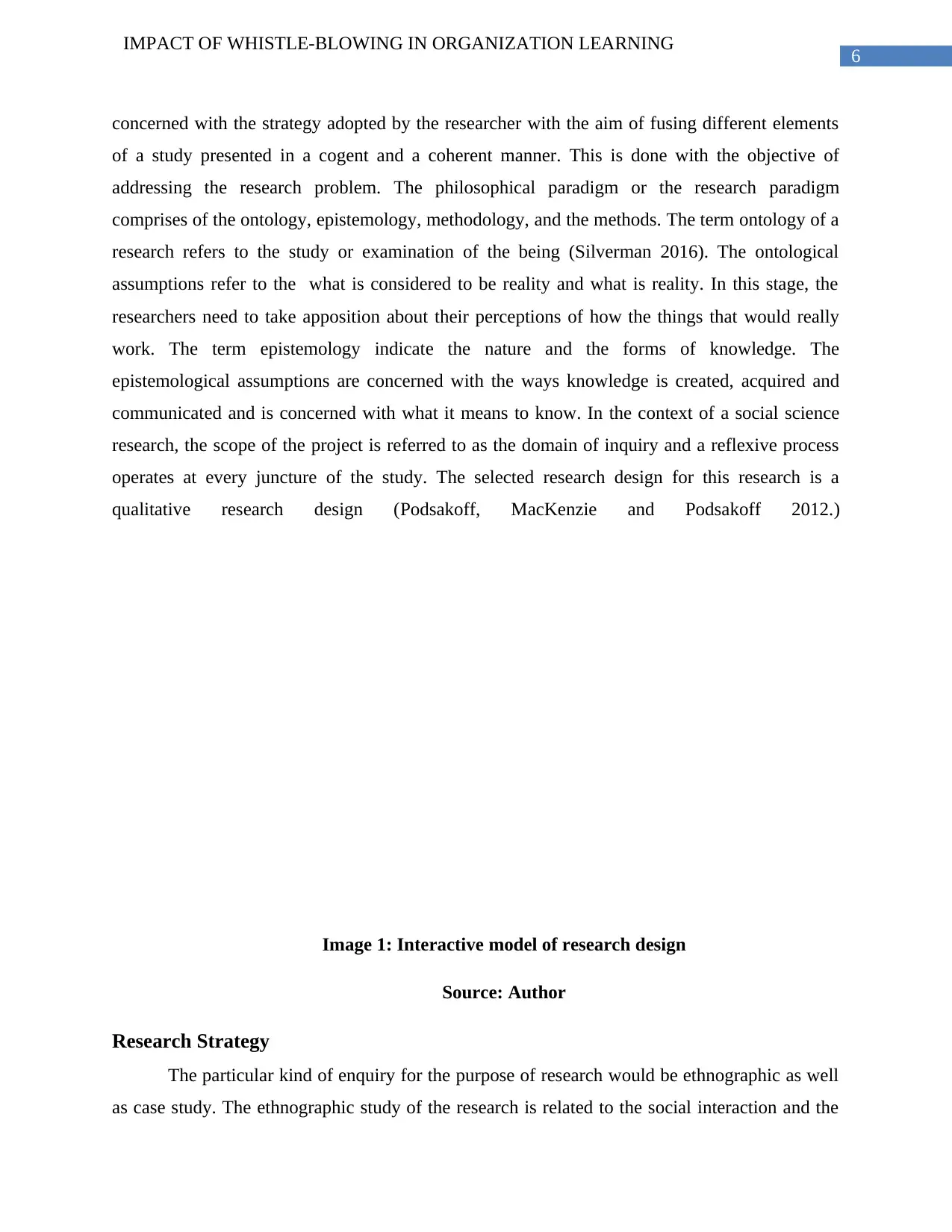
6
IMPACT OF WHISTLE-BLOWING IN ORGANIZATION LEARNING
concerned with the strategy adopted by the researcher with the aim of fusing different elements
of a study presented in a cogent and a coherent manner. This is done with the objective of
addressing the research problem. The philosophical paradigm or the research paradigm
comprises of the ontology, epistemology, methodology, and the methods. The term ontology of a
research refers to the study or examination of the being (Silverman 2016). The ontological
assumptions refer to the what is considered to be reality and what is reality. In this stage, the
researchers need to take apposition about their perceptions of how the things that would really
work. The term epistemology indicate the nature and the forms of knowledge. The
epistemological assumptions are concerned with the ways knowledge is created, acquired and
communicated and is concerned with what it means to know. In the context of a social science
research, the scope of the project is referred to as the domain of inquiry and a reflexive process
operates at every juncture of the study. The selected research design for this research is a
qualitative research design (Podsakoff, MacKenzie and Podsakoff 2012.)
Image 1: Interactive model of research design
Source: Author
Research Strategy
The particular kind of enquiry for the purpose of research would be ethnographic as well
as case study. The ethnographic study of the research is related to the social interaction and the
IMPACT OF WHISTLE-BLOWING IN ORGANIZATION LEARNING
concerned with the strategy adopted by the researcher with the aim of fusing different elements
of a study presented in a cogent and a coherent manner. This is done with the objective of
addressing the research problem. The philosophical paradigm or the research paradigm
comprises of the ontology, epistemology, methodology, and the methods. The term ontology of a
research refers to the study or examination of the being (Silverman 2016). The ontological
assumptions refer to the what is considered to be reality and what is reality. In this stage, the
researchers need to take apposition about their perceptions of how the things that would really
work. The term epistemology indicate the nature and the forms of knowledge. The
epistemological assumptions are concerned with the ways knowledge is created, acquired and
communicated and is concerned with what it means to know. In the context of a social science
research, the scope of the project is referred to as the domain of inquiry and a reflexive process
operates at every juncture of the study. The selected research design for this research is a
qualitative research design (Podsakoff, MacKenzie and Podsakoff 2012.)
Image 1: Interactive model of research design
Source: Author
Research Strategy
The particular kind of enquiry for the purpose of research would be ethnographic as well
as case study. The ethnographic study of the research is related to the social interaction and the
Paraphrase This Document
Need a fresh take? Get an instant paraphrase of this document with our AI Paraphraser
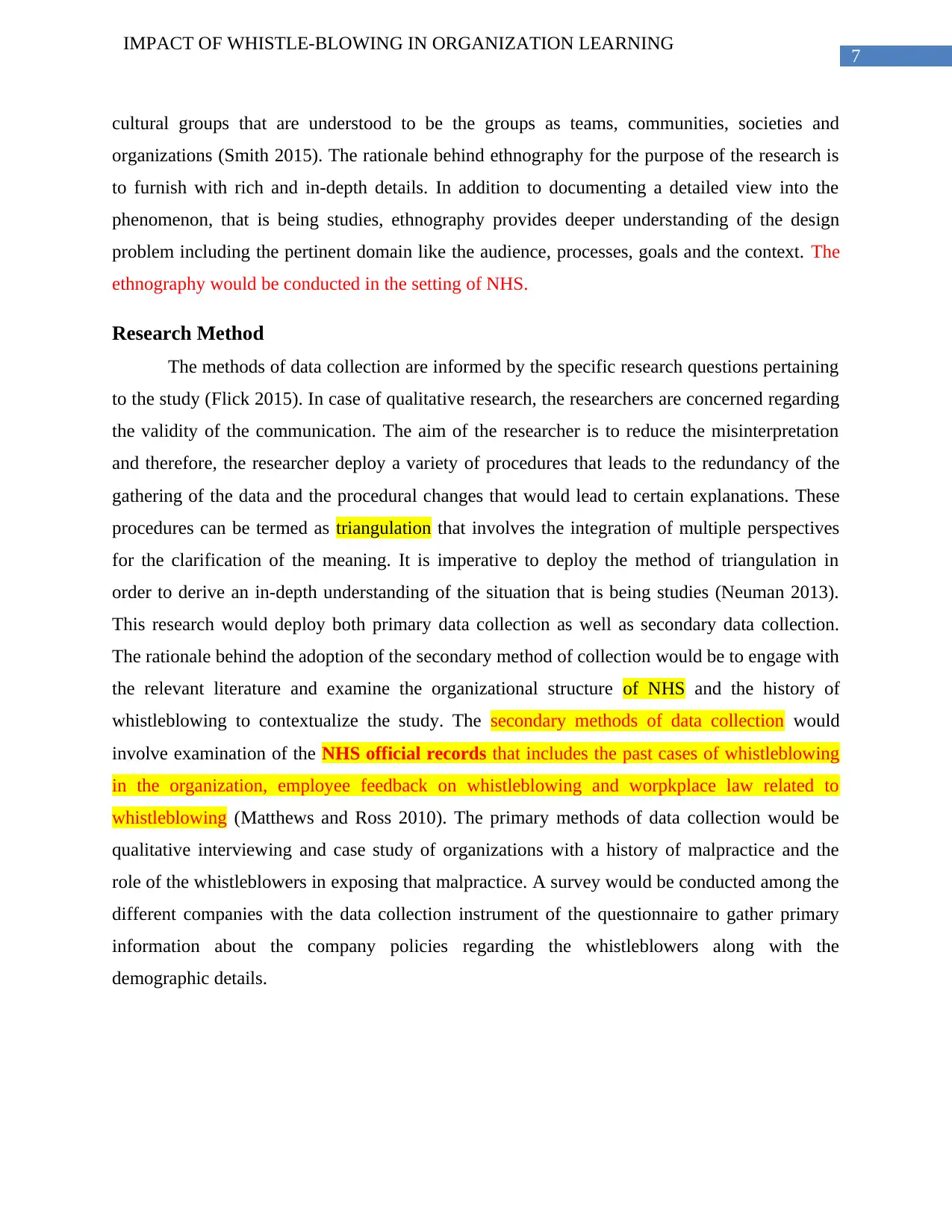
7
IMPACT OF WHISTLE-BLOWING IN ORGANIZATION LEARNING
cultural groups that are understood to be the groups as teams, communities, societies and
organizations (Smith 2015). The rationale behind ethnography for the purpose of the research is
to furnish with rich and in-depth details. In addition to documenting a detailed view into the
phenomenon, that is being studies, ethnography provides deeper understanding of the design
problem including the pertinent domain like the audience, processes, goals and the context. The
ethnography would be conducted in the setting of NHS.
Research Method
The methods of data collection are informed by the specific research questions pertaining
to the study (Flick 2015). In case of qualitative research, the researchers are concerned regarding
the validity of the communication. The aim of the researcher is to reduce the misinterpretation
and therefore, the researcher deploy a variety of procedures that leads to the redundancy of the
gathering of the data and the procedural changes that would lead to certain explanations. These
procedures can be termed as triangulation that involves the integration of multiple perspectives
for the clarification of the meaning. It is imperative to deploy the method of triangulation in
order to derive an in-depth understanding of the situation that is being studies (Neuman 2013).
This research would deploy both primary data collection as well as secondary data collection.
The rationale behind the adoption of the secondary method of collection would be to engage with
the relevant literature and examine the organizational structure of NHS and the history of
whistleblowing to contextualize the study. The secondary methods of data collection would
involve examination of the NHS official records that includes the past cases of whistleblowing
in the organization, employee feedback on whistleblowing and worpkplace law related to
whistleblowing (Matthews and Ross 2010). The primary methods of data collection would be
qualitative interviewing and case study of organizations with a history of malpractice and the
role of the whistleblowers in exposing that malpractice. A survey would be conducted among the
different companies with the data collection instrument of the questionnaire to gather primary
information about the company policies regarding the whistleblowers along with the
demographic details.
IMPACT OF WHISTLE-BLOWING IN ORGANIZATION LEARNING
cultural groups that are understood to be the groups as teams, communities, societies and
organizations (Smith 2015). The rationale behind ethnography for the purpose of the research is
to furnish with rich and in-depth details. In addition to documenting a detailed view into the
phenomenon, that is being studies, ethnography provides deeper understanding of the design
problem including the pertinent domain like the audience, processes, goals and the context. The
ethnography would be conducted in the setting of NHS.
Research Method
The methods of data collection are informed by the specific research questions pertaining
to the study (Flick 2015). In case of qualitative research, the researchers are concerned regarding
the validity of the communication. The aim of the researcher is to reduce the misinterpretation
and therefore, the researcher deploy a variety of procedures that leads to the redundancy of the
gathering of the data and the procedural changes that would lead to certain explanations. These
procedures can be termed as triangulation that involves the integration of multiple perspectives
for the clarification of the meaning. It is imperative to deploy the method of triangulation in
order to derive an in-depth understanding of the situation that is being studies (Neuman 2013).
This research would deploy both primary data collection as well as secondary data collection.
The rationale behind the adoption of the secondary method of collection would be to engage with
the relevant literature and examine the organizational structure of NHS and the history of
whistleblowing to contextualize the study. The secondary methods of data collection would
involve examination of the NHS official records that includes the past cases of whistleblowing
in the organization, employee feedback on whistleblowing and worpkplace law related to
whistleblowing (Matthews and Ross 2010). The primary methods of data collection would be
qualitative interviewing and case study of organizations with a history of malpractice and the
role of the whistleblowers in exposing that malpractice. A survey would be conducted among the
different companies with the data collection instrument of the questionnaire to gather primary
information about the company policies regarding the whistleblowers along with the
demographic details.
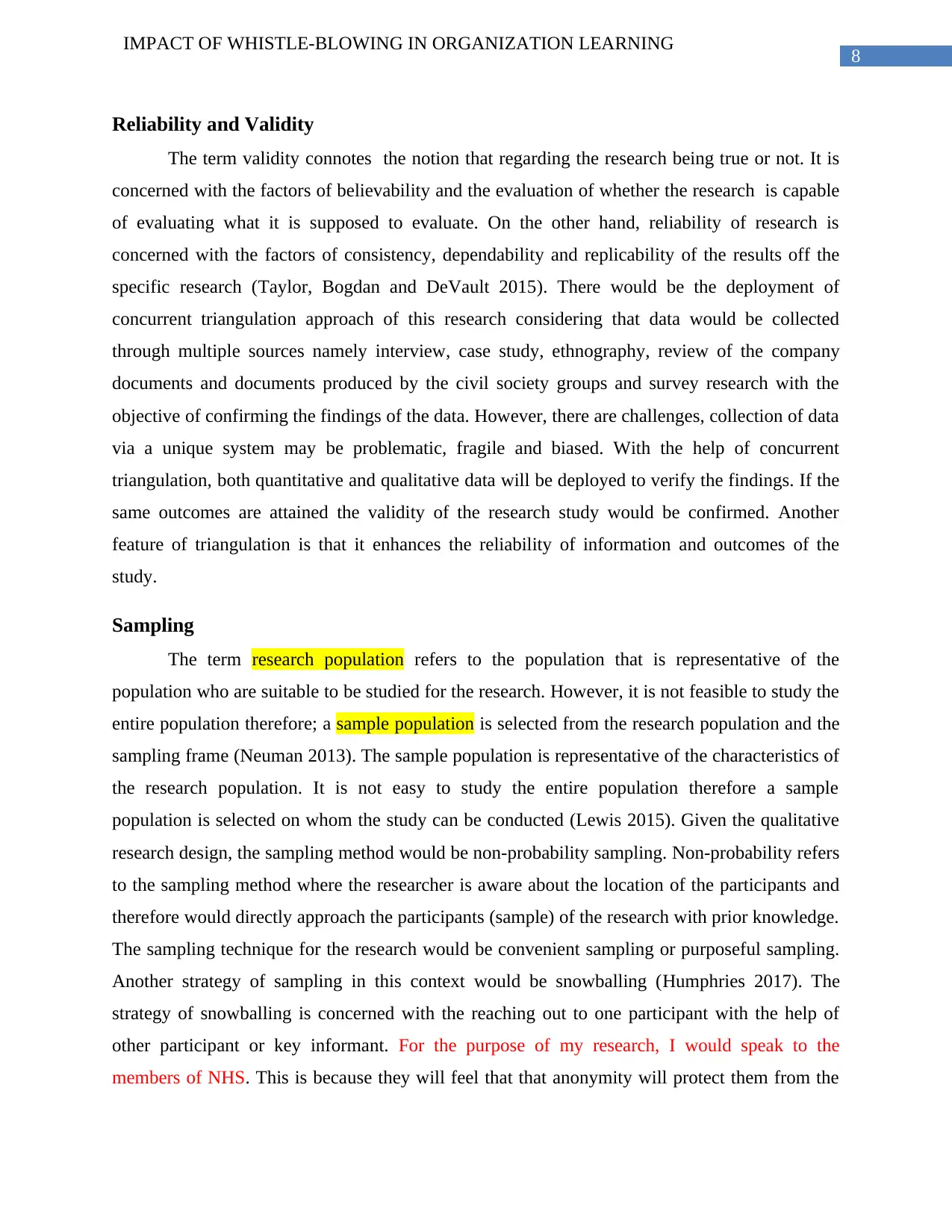
8
IMPACT OF WHISTLE-BLOWING IN ORGANIZATION LEARNING
Reliability and Validity
The term validity connotes the notion that regarding the research being true or not. It is
concerned with the factors of believability and the evaluation of whether the research is capable
of evaluating what it is supposed to evaluate. On the other hand, reliability of research is
concerned with the factors of consistency, dependability and replicability of the results off the
specific research (Taylor, Bogdan and DeVault 2015). There would be the deployment of
concurrent triangulation approach of this research considering that data would be collected
through multiple sources namely interview, case study, ethnography, review of the company
documents and documents produced by the civil society groups and survey research with the
objective of confirming the findings of the data. However, there are challenges, collection of data
via a unique system may be problematic, fragile and biased. With the help of concurrent
triangulation, both quantitative and qualitative data will be deployed to verify the findings. If the
same outcomes are attained the validity of the research study would be confirmed. Another
feature of triangulation is that it enhances the reliability of information and outcomes of the
study.
Sampling
The term research population refers to the population that is representative of the
population who are suitable to be studied for the research. However, it is not feasible to study the
entire population therefore; a sample population is selected from the research population and the
sampling frame (Neuman 2013). The sample population is representative of the characteristics of
the research population. It is not easy to study the entire population therefore a sample
population is selected on whom the study can be conducted (Lewis 2015). Given the qualitative
research design, the sampling method would be non-probability sampling. Non-probability refers
to the sampling method where the researcher is aware about the location of the participants and
therefore would directly approach the participants (sample) of the research with prior knowledge.
The sampling technique for the research would be convenient sampling or purposeful sampling.
Another strategy of sampling in this context would be snowballing (Humphries 2017). The
strategy of snowballing is concerned with the reaching out to one participant with the help of
other participant or key informant. For the purpose of my research, I would speak to the
members of NHS. This is because they will feel that that anonymity will protect them from the
IMPACT OF WHISTLE-BLOWING IN ORGANIZATION LEARNING
Reliability and Validity
The term validity connotes the notion that regarding the research being true or not. It is
concerned with the factors of believability and the evaluation of whether the research is capable
of evaluating what it is supposed to evaluate. On the other hand, reliability of research is
concerned with the factors of consistency, dependability and replicability of the results off the
specific research (Taylor, Bogdan and DeVault 2015). There would be the deployment of
concurrent triangulation approach of this research considering that data would be collected
through multiple sources namely interview, case study, ethnography, review of the company
documents and documents produced by the civil society groups and survey research with the
objective of confirming the findings of the data. However, there are challenges, collection of data
via a unique system may be problematic, fragile and biased. With the help of concurrent
triangulation, both quantitative and qualitative data will be deployed to verify the findings. If the
same outcomes are attained the validity of the research study would be confirmed. Another
feature of triangulation is that it enhances the reliability of information and outcomes of the
study.
Sampling
The term research population refers to the population that is representative of the
population who are suitable to be studied for the research. However, it is not feasible to study the
entire population therefore; a sample population is selected from the research population and the
sampling frame (Neuman 2013). The sample population is representative of the characteristics of
the research population. It is not easy to study the entire population therefore a sample
population is selected on whom the study can be conducted (Lewis 2015). Given the qualitative
research design, the sampling method would be non-probability sampling. Non-probability refers
to the sampling method where the researcher is aware about the location of the participants and
therefore would directly approach the participants (sample) of the research with prior knowledge.
The sampling technique for the research would be convenient sampling or purposeful sampling.
Another strategy of sampling in this context would be snowballing (Humphries 2017). The
strategy of snowballing is concerned with the reaching out to one participant with the help of
other participant or key informant. For the purpose of my research, I would speak to the
members of NHS. This is because they will feel that that anonymity will protect them from the
⊘ This is a preview!⊘
Do you want full access?
Subscribe today to unlock all pages.

Trusted by 1+ million students worldwide
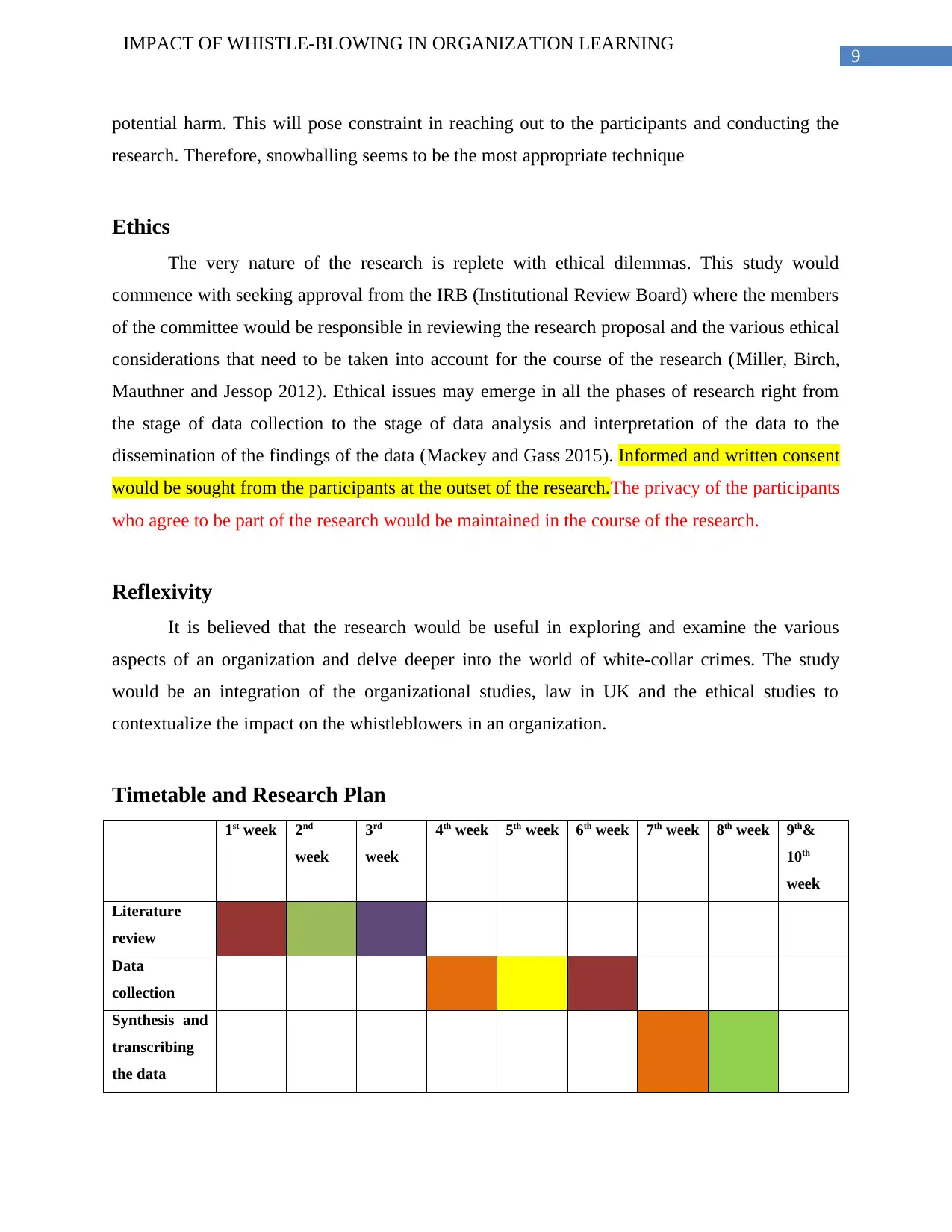
9
IMPACT OF WHISTLE-BLOWING IN ORGANIZATION LEARNING
potential harm. This will pose constraint in reaching out to the participants and conducting the
research. Therefore, snowballing seems to be the most appropriate technique
Ethics
The very nature of the research is replete with ethical dilemmas. This study would
commence with seeking approval from the IRB (Institutional Review Board) where the members
of the committee would be responsible in reviewing the research proposal and the various ethical
considerations that need to be taken into account for the course of the research (Miller, Birch,
Mauthner and Jessop 2012). Ethical issues may emerge in all the phases of research right from
the stage of data collection to the stage of data analysis and interpretation of the data to the
dissemination of the findings of the data (Mackey and Gass 2015). Informed and written consent
would be sought from the participants at the outset of the research.The privacy of the participants
who agree to be part of the research would be maintained in the course of the research.
Reflexivity
It is believed that the research would be useful in exploring and examine the various
aspects of an organization and delve deeper into the world of white-collar crimes. The study
would be an integration of the organizational studies, law in UK and the ethical studies to
contextualize the impact on the whistleblowers in an organization.
Timetable and Research Plan
1st week 2nd
week
3rd
week
4th week 5th week 6th week 7th week 8th week 9th&
10th
week
Literature
review
Data
collection
Synthesis and
transcribing
the data
IMPACT OF WHISTLE-BLOWING IN ORGANIZATION LEARNING
potential harm. This will pose constraint in reaching out to the participants and conducting the
research. Therefore, snowballing seems to be the most appropriate technique
Ethics
The very nature of the research is replete with ethical dilemmas. This study would
commence with seeking approval from the IRB (Institutional Review Board) where the members
of the committee would be responsible in reviewing the research proposal and the various ethical
considerations that need to be taken into account for the course of the research (Miller, Birch,
Mauthner and Jessop 2012). Ethical issues may emerge in all the phases of research right from
the stage of data collection to the stage of data analysis and interpretation of the data to the
dissemination of the findings of the data (Mackey and Gass 2015). Informed and written consent
would be sought from the participants at the outset of the research.The privacy of the participants
who agree to be part of the research would be maintained in the course of the research.
Reflexivity
It is believed that the research would be useful in exploring and examine the various
aspects of an organization and delve deeper into the world of white-collar crimes. The study
would be an integration of the organizational studies, law in UK and the ethical studies to
contextualize the impact on the whistleblowers in an organization.
Timetable and Research Plan
1st week 2nd
week
3rd
week
4th week 5th week 6th week 7th week 8th week 9th&
10th
week
Literature
review
Data
collection
Synthesis and
transcribing
the data
Paraphrase This Document
Need a fresh take? Get an instant paraphrase of this document with our AI Paraphraser
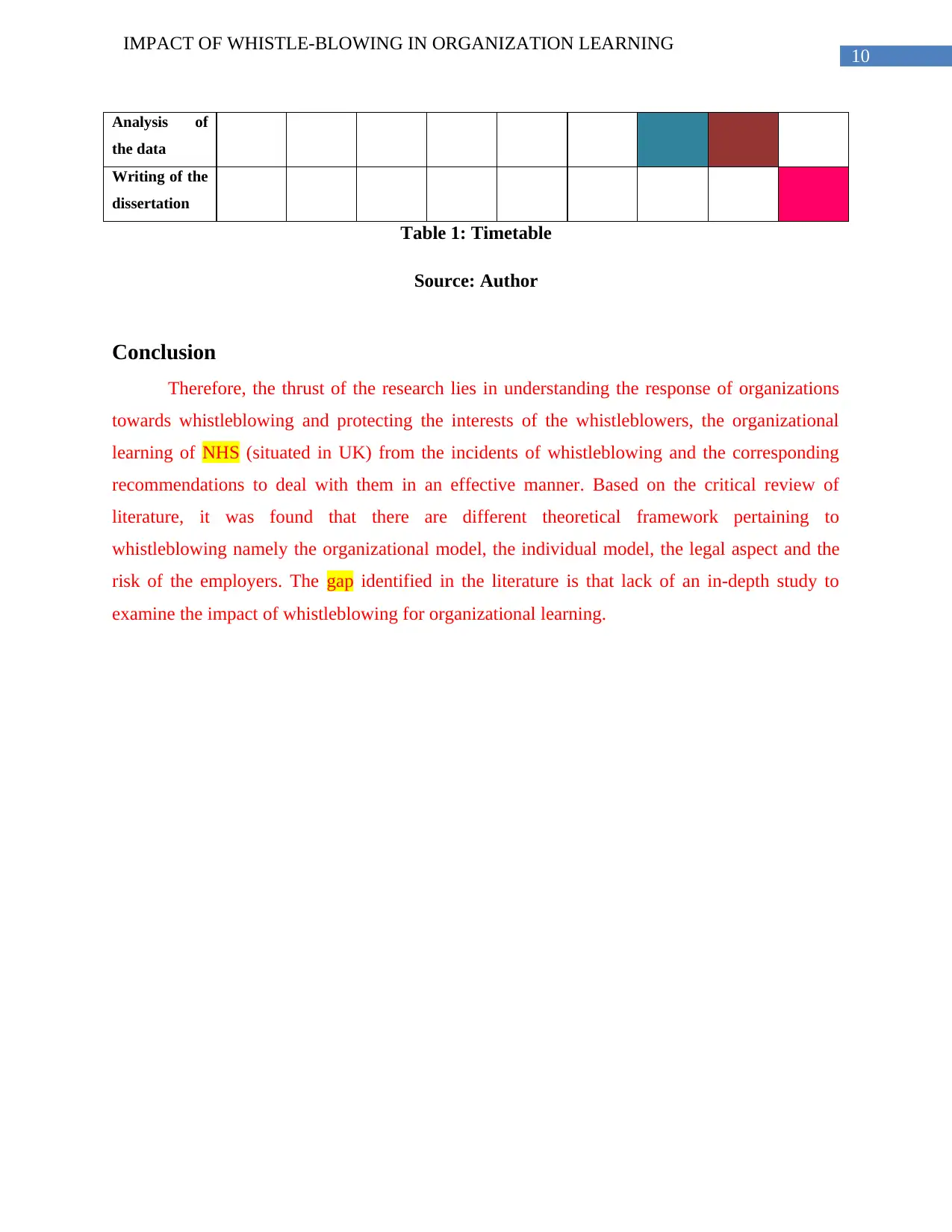
10
IMPACT OF WHISTLE-BLOWING IN ORGANIZATION LEARNING
Analysis of
the data
Writing of the
dissertation
Table 1: Timetable
Source: Author
Conclusion
Therefore, the thrust of the research lies in understanding the response of organizations
towards whistleblowing and protecting the interests of the whistleblowers, the organizational
learning of NHS (situated in UK) from the incidents of whistleblowing and the corresponding
recommendations to deal with them in an effective manner. Based on the critical review of
literature, it was found that there are different theoretical framework pertaining to
whistleblowing namely the organizational model, the individual model, the legal aspect and the
risk of the employers. The gap identified in the literature is that lack of an in-depth study to
examine the impact of whistleblowing for organizational learning.
IMPACT OF WHISTLE-BLOWING IN ORGANIZATION LEARNING
Analysis of
the data
Writing of the
dissertation
Table 1: Timetable
Source: Author
Conclusion
Therefore, the thrust of the research lies in understanding the response of organizations
towards whistleblowing and protecting the interests of the whistleblowers, the organizational
learning of NHS (situated in UK) from the incidents of whistleblowing and the corresponding
recommendations to deal with them in an effective manner. Based on the critical review of
literature, it was found that there are different theoretical framework pertaining to
whistleblowing namely the organizational model, the individual model, the legal aspect and the
risk of the employers. The gap identified in the literature is that lack of an in-depth study to
examine the impact of whistleblowing for organizational learning.
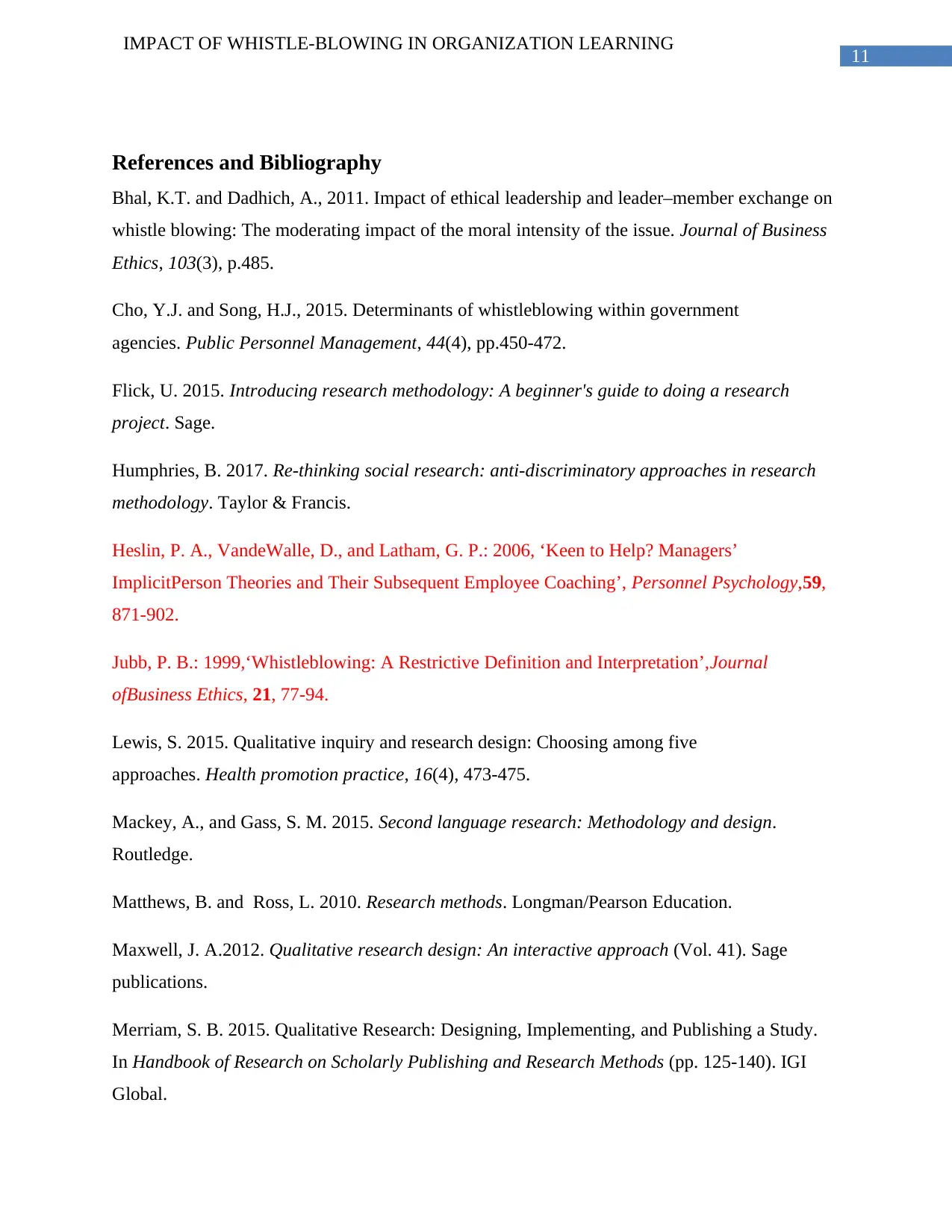
11
IMPACT OF WHISTLE-BLOWING IN ORGANIZATION LEARNING
References and Bibliography
Bhal, K.T. and Dadhich, A., 2011. Impact of ethical leadership and leader–member exchange on
whistle blowing: The moderating impact of the moral intensity of the issue. Journal of Business
Ethics, 103(3), p.485.
Cho, Y.J. and Song, H.J., 2015. Determinants of whistleblowing within government
agencies. Public Personnel Management, 44(4), pp.450-472.
Flick, U. 2015. Introducing research methodology: A beginner's guide to doing a research
project. Sage.
Humphries, B. 2017. Re-thinking social research: anti-discriminatory approaches in research
methodology. Taylor & Francis.
Heslin, P. A., VandeWalle, D., and Latham, G. P.: 2006, ‘Keen to Help? Managers’
ImplicitPerson Theories and Their Subsequent Employee Coaching’, Personnel Psychology,59,
871-902.
Jubb, P. B.: 1999,‘Whistleblowing: A Restrictive Definition and Interpretation’,Journal
ofBusiness Ethics, 21, 77-94.
Lewis, S. 2015. Qualitative inquiry and research design: Choosing among five
approaches. Health promotion practice, 16(4), 473-475.
Mackey, A., and Gass, S. M. 2015. Second language research: Methodology and design.
Routledge.
Matthews, B. and Ross, L. 2010. Research methods. Longman/Pearson Education.
Maxwell, J. A.2012. Qualitative research design: An interactive approach (Vol. 41). Sage
publications.
Merriam, S. B. 2015. Qualitative Research: Designing, Implementing, and Publishing a Study.
In Handbook of Research on Scholarly Publishing and Research Methods (pp. 125-140). IGI
Global.
IMPACT OF WHISTLE-BLOWING IN ORGANIZATION LEARNING
References and Bibliography
Bhal, K.T. and Dadhich, A., 2011. Impact of ethical leadership and leader–member exchange on
whistle blowing: The moderating impact of the moral intensity of the issue. Journal of Business
Ethics, 103(3), p.485.
Cho, Y.J. and Song, H.J., 2015. Determinants of whistleblowing within government
agencies. Public Personnel Management, 44(4), pp.450-472.
Flick, U. 2015. Introducing research methodology: A beginner's guide to doing a research
project. Sage.
Humphries, B. 2017. Re-thinking social research: anti-discriminatory approaches in research
methodology. Taylor & Francis.
Heslin, P. A., VandeWalle, D., and Latham, G. P.: 2006, ‘Keen to Help? Managers’
ImplicitPerson Theories and Their Subsequent Employee Coaching’, Personnel Psychology,59,
871-902.
Jubb, P. B.: 1999,‘Whistleblowing: A Restrictive Definition and Interpretation’,Journal
ofBusiness Ethics, 21, 77-94.
Lewis, S. 2015. Qualitative inquiry and research design: Choosing among five
approaches. Health promotion practice, 16(4), 473-475.
Mackey, A., and Gass, S. M. 2015. Second language research: Methodology and design.
Routledge.
Matthews, B. and Ross, L. 2010. Research methods. Longman/Pearson Education.
Maxwell, J. A.2012. Qualitative research design: An interactive approach (Vol. 41). Sage
publications.
Merriam, S. B. 2015. Qualitative Research: Designing, Implementing, and Publishing a Study.
In Handbook of Research on Scholarly Publishing and Research Methods (pp. 125-140). IGI
Global.
⊘ This is a preview!⊘
Do you want full access?
Subscribe today to unlock all pages.

Trusted by 1+ million students worldwide
1 out of 14
Related Documents
Your All-in-One AI-Powered Toolkit for Academic Success.
+13062052269
info@desklib.com
Available 24*7 on WhatsApp / Email
![[object Object]](/_next/static/media/star-bottom.7253800d.svg)
Unlock your academic potential
Copyright © 2020–2025 A2Z Services. All Rights Reserved. Developed and managed by ZUCOL.




